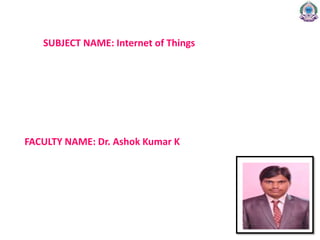
Io t introduction
- 1. SUBJECT NAME: Internet of Things FACULTY NAME: Dr. Ashok Kumar K
- 2. Unit-1 IoT-An Architectural Overview • The Internet of Things, also called The Internet of Objects, refers to a wireless network between objects, usually the network will be wireless and self-configuring, such as household appliances. (Wikipedia) • The term "Internet of Things" has come to describe a number of technologies and research disciplines that enable the Internet to reach out into the real world of physical objects. (IoT 2008) • “Things having identities and virtual personalities operating in smart spaces using intelligent interfaces to connect and communicate within social, environmental, and user contexts”. (IoT in 2020)
- 3. IoT-An Architectural Overview • Characteristics of IoT 1. Intelligence – Knowledge extraction from the generated data 2. Architecture – A hybrid architecture supporting many others 3. Complex system – A diverse set of dynamically changing objects 4. Size considerations – Scalability 5. Time considerations – Billions of parallel and simultaneous events 6. Space considerations – Localization 7. Everything-as-a-service – Consuming resources as a service
- 4. LOGICAL DESIGN OF IOT • In this article we discuss Logical design of Internet of things. Logical design of IoT system refers to an abstract representation of the entities & processes without going into the low-level specifies of the implementation. • For understanding Logical Design of IoT, we describes given below terms. 1. IoT Functional Blocks 2. IoT Communication Models 3. IoT Communication APIs
- 6. Functional blocks • Device: An IoT system comprises of devices that provide sensing, actuation, and monitoring and control functions. • Communication: Handles the communication for the IoT system. • Services: services for device monitoring, device control service, data publishing services and services for device discovery • Management: This block provides various functions to govern the IoT system. • Security: this block secures the IoT system and by providing functions such as authentication, authorization, message and content integrity, and data security. • Application: This is an interface that the users can use to control and monitor various aspects of the IoT system. Application also allows users to view the system status and view or analyze the processed data.
- 7. REQUEST–RESPONSE COMMUNICATION MODEL REQUEST–RESPONSE IS A COMMUNICATION MODEL IN WHICH THE CLIENT SENDS REQUESTS TO THE SERVER AND THE SERVER RESPONDS TO THE REQUESTS. OUTCOMES: STUDENT WILL BE ABLE UNDERSTAND DIFFERENT COMMUNICATION MODELS Communication Models
- 8. PUBLISH–SUBSCRIBE COMMUNICATION MODEL PUBLISH–SUBSCRIBE IS A COMMUNICATION MODEL THAT INVOLVES PUBLISHERS, BROKERS AND CONSUMERS. PUBLISHERS ARE THE SOURCE OF DATA. PUBLISHERS SEND THE DATA TO THE TOPICS WHICH ARE MANAGED BY THE BROKER. PUBLISHERS ARE NOT AWARE OF THE CONSUMERS. OUTCOMES: STUDENT WILL BE ABLE UNDERSTAND DIFFERENT COMMUNICATION MODELS Communication Models
- 9. PUSH–PULL COMMUNICATION MODEL PUSH–PULL IS A COMMUNICATION MODEL IN WHICH THE DATA PRODUCERS PUSH THE DATA TO QUEUES AND THE CONSUMERS PULL THE DATA FROM THE QUEUES. PRODUCERS DO NOT NEED TO BE AWARE OF THE CONSUMERS. OUTCOMES: STUDENT WILL BE ABLE UNDERSTAND DIFFERENT COMMUNICATION MODELS Communication models
- 10. EXCLUSIVE PAIR COMMUNICATION MODELS EXCLUSIVE PAIR IS A BIDIRECTIONAL, FULLY DUPLEX COMMUNICATION MODEL THAT USES A PERSISTENT CONNECTION BETWEEN THE CLIENT AND THE SERVER. OUTCOMES: STUDENT WILL BE ABLE UNDERSTAND DIFFERENT COMMUNICATION MODELS Communication models
- 11. REST-BASED COMMUNICATION APIS REPRESENTATIONAL STATE TRANSFER (REST) IS A SET OF ARCHITECTURAL PRINCIPLES BY WHICH YOU CAN DESIGN WEB SERVICES AND WEB APIS THAT FOCUS ON A SYSTEM’S RESOURCES AND HOW RESOURCE STATES ARE ADDRESSED AND TRANSFERRED. OUTCOMES: STUDENT WILL BE ABLE UNDERSTAND DIFFERENT COMMUNICATION APIS API
- 12. WEBSOCKET-BASED COMMUNICATION APIS WEBSOCKET APIS ALLOW BI-DIRECTIONAL, FULL DUPLEX COMMUNICATION BETWEEN CLIENTS AND SERVERS. OUTCOMES: STUDENT WILL BE ABLE UNDERSTAND DIFFERENT COMMUNICATION APIS API
- 13. OUTCOMES: STUDENT WILL BE ABLE UNDERSTAND DIFFERENCES BETWEEN COMMUNICATION APIS Difference between REST and WebSocket-based Communication APIs
- 14. PHYSICAL DESIGN OF IOT
- 16. LINK LAYER 802.3 – ETHERNET 802.11 – WIFI 802.16 – WIMAX 802.15.4 – LR-WPAN 2G/3G/4G NETWORK/INTERNET LAYER IPV4, IPV6, 6LOWPAN TRANSPORT LAYER TCP, UDP APPLICATION LAYER HTTP, COAP, WEBSOCKET, MQTT, XMPP, DDS, AMQP OUTCOMES: STUDENT WILL BE ABLE UNDERSTAND IOT PROTOCOLS IoT Protocols
- 17. DESIGN PRINCIPLES Prepare for Evolving User Actions Leverage Create Contextual Experiences Account for Premeditated Actions Connect People
- 18. CONSIDERATIONS FOR IOT SOLUTIONS IoT Security IoT Analytics IoT Device (Thing) Management Low-Power, Short-Range IoT Networks Low-Power, Wide-Area Networks IoT Processors IoT Operating Systems Event Stream Processing IoT Platforms IoT Standards and Ecosystems
- 19. M2M AND IOT TECHNOLOGY FUNDAMENTALS smart device / sensor layer: The lowest layer is made up of smart objects integrated with sensors. The sensors enable the interconnection of the physical and digital worlds allowing real-time information to be collected and processed. There are various types of sensors for different purposes. The sensors have the capacity to take measurements such as temperature, air quality, speed, humidity, pressure, flow, movement and electricity etc. In some cases, they may also have a degree of memory, enabling them to record a certain number of measurements. A sensor can measure the physical property and convert it into signal that can be understood by an instrument. Sensors are grouped according to their unique purpose such as environmental sensors, body sensors, home appliance sensors and vehicle telematics sensors, etc. Most sensors require connectivity to the sensor gateways. This can be in the form of a Local Area Network (LAN) such as Ethernet and Wi-Fi connections or Personal Area Network (PAN) such as ZigBee, Bluetooth and Ultra Wideband (UWB). For sensors that do not require connectivity to sensor aggregators, their connectivity to backend servers/applications can be provided using Wide Area Network (WAN) such as GSM, GPRS and LTE. Sensors that use low power and low data rate connectivity, they typically form networks commonly known as wireless sensor networks (WSNs).
Notes de l'éditeur
- Things in IoT IoT Protocols